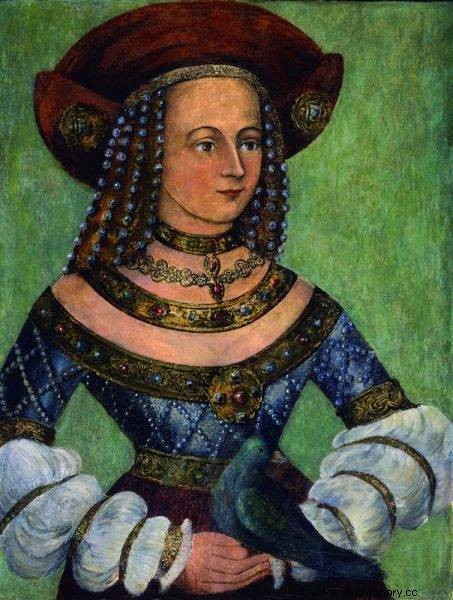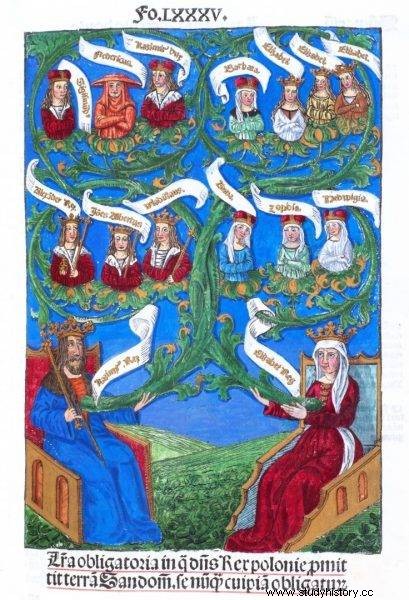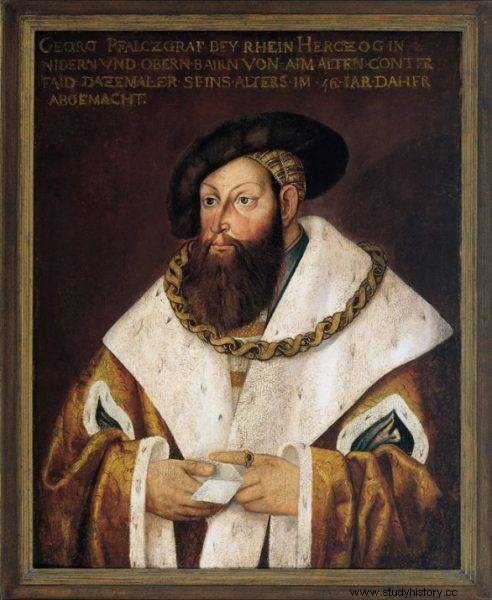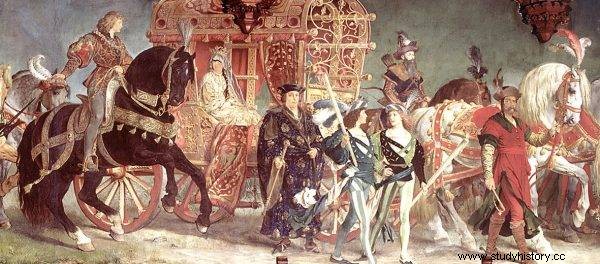500 years ago a Polish princess married a Bavarian prince. Their fairy-tale wedding is celebrated to this day, although the bride and groom were not destined to live happily ever after.
Every four years, Bavaria's Landshut hosts one of the largest medieval festivals on the continent. Thousands of people from all over the world come to take part in the wedding celebrations that Europe talked about five centuries ago. The Polish princess then married a Bavarian prince, perhaps hoping that they would be given a long and happy life ...
"There were five of them, not counting Elizabeth, who died in childhood," wrote Fryderyk Papée about the daughters of Elżbieta Rakuszanka and Kazimierz Jagiellończyk, professor of the Jagiellonian University, director of the Jagiellonian Library, Polish historian of French origin, over a hundred years ago. - All of the German princes left Pomerania in an arc down to Bavaria. All of them had a nice exterior, as can be deduced from contemporary descriptions and portraits, all of them held high, exuding a royal glow right at the entrance to the new homeland, in clothes, in a device, in jewels . Queen of "die Königin", each of them was called at those princely courts until the end of their lives ”.
Jadwiga was the eldest to marry the first - her father planned an alliance with the Bavarian prince, and the princess saw her future husband just a few hours before the wedding.
Difficult road to the hand of the Polish princess
Jadwiga Jagiellonka was born on September 21, 1457 in Krakow as the eldest of the daughters and the second child of Kazimierz Jagiellończyk and Elżbieta Rakuszanka. At baptism - in line with the family tradition - was named after Jadwiga of Angaweńska . It was known from the beginning that the princess would be a perfect match and her competitors would start to line up before she reached the age for marriage.
The king of Hungary, Maciej Korwin, showed the greatest stubbornness by sending a legation to Kraków four times. However, both King Kazimierz and his wife were not favorable to this marriage. Habsburg descending from the Habsburg family Elżbieta Rakuszanka was strongly against any mere aristocrat who had made his way to the throne himself against the Habsburgs' plans to marry her daughter . She was supposed to say indignantly:"Matyasz, peasant, chicken, Wołoszyn, dog, I displease her!" and made efforts to marry Jadwiga to the imperial son, Maksymilian.

Jadwiga Jagiellonka
The king, in turn, had other plans - he wanted to strengthen the south-western border with the Czechs in opposition to Corvinus, and this goal would be served by an alliance with Bavaria.
A provincial prince and daughter of a king
Hence, Jadwiga was married off to Jerzy the Rich of the Wittelsbach family, son of Prince Ludwik IX the Rich, and negotiations began in 1473. It was then that Stanisław Kurozwęcki and Paweł Jasieński began talks with the Bavarian side. A year later, in September, Ludwik IX sent a legation to Krakow with an official request for Jadwiga's hand for his son.
Further negotiations continued over the next months - ultimately, as German historian Peter Oliver Leow writes, "the provincial prince's wedding to the king's daughter, no matter how rich he was, required good reasons" - until December 30 in Radom, Jadwiga gave her consent and a day later, on New Year's Eve, the marriage contract was signed. According to it, the princess was to receive a dowry in the amount of 32 thousand. Hungarian zlotys payable over 5 years in five tranches . The value of her wedding trip was estimated at almost PLN 100,000. zlotys .

King Kazimierz Jagiellończyk with Queen Elizabeth Rakuszanka and their thirteen children
However, before the eighteen-year-old princess could stand on the wedding carpet, it was necessary to complete the required church formalities. The young were relatives of the third degree (their grandparents, Albrecht II Habsburg and Małgorzata Habsburżanka, were siblings), so a papal dispensation was required. Crown Chancellor Uriel Górka obtained it from Sixtus IV on May 26, 1475).
A long journey
Jadwiga could finally set off to see her future husband. Her family accompanied her to Poznań. From there, the future bride set out with a retinue of 1,200 horses and about a hundred vehicles, accompanied by Princess Anna of Cieszyn, widow of Bolesław II, niece of her grandmother, Queen Zofia Holszańska. Jadwiga arrived in Wittenberg on October 23, 1475. It was received by a delegation from Landshut. The king, who was accompanying his daughter, was indignant that his fiancé did not come in person and stopped the journey for a few days .
The outbreak of the epidemic caused further delays. The princess's retinue had to make some way, so Jadwiga didn't reach Landshut until mid-November (according to the contract, she was supposed to come a month earlier). She brought a wonderful wedding trip, which consisted of extremely valuable fabrics, jewels and everyday objects. As we read in the princess's wedding inventory, containing a list of clothes, bedding, silverware, jewels and everyday items, Jadwiga took with her the most beautiful and expensive dresses, furs and fabrics (e.g. silk cover of the bed with gold, richly decorated coats and hosiery, including the most valued then sables, pearl embroidered dresses made of velvet, silk and damask), exquisite table and bathroom silverware, and lots of jewels and ornaments.
On November 14, Jadwiga entered Bavarian Landshut in a golden carriage, decorated with four carved gilded lions holding shields with the coats of arms of the Kingdom of Poland. According to reports at the time, the carriage was preceded by four Lithuanians on small horses "[...] dressed like Turks, with quivers, bows and other Turkish tools." As we read on:
As the queen was coming, the princes got off their horses, and with them some lords and nobles, and together they went to her carriage. […] The queen was seated in her golden carriage. She wore a golden outer garment and a scarf draped over her face except for her eyes. Without leaving her carriage, she extended her hand and bowed to the princes. They bowed extremely low.
Fairytale wedding
Greeted by her future husband and Emperor Frederick, Jadwiga then went to the Church of St. Martin, where she was dressed up as a bride. More specifically:"[...] a precious dress made to measure in line with the Polish tradition ; it was a wide red satin silk dress with wide long sleeves, fully embroidered with beautiful pearls. "
The wedding headdress of the Polish princess was delightful - it consisted of a pearl headband to keep the hairstyle, a thin veil and a magnificent golden crown richly decorated with jewels. When the choir intoned Te Deum laudamus Jadwiga burst into tears. Perhaps they were tears of emotion, and perhaps the princess had a feeling that her married life would not be dotted with roses ? However, after the wedding, it was time to celebrate - a sumptuous wedding was organized, attended by approx. 10,000 people. guests.

The Landshut wedding was like a fairy tale.
The Landshut wedding was like a fairy tale story. It became famous as one of the greatest shows in Europe at that time. Emperor Frederick personally led the bride in the first dance, and the presence of the party was graced by eminent guests - the imperial son and would-be candidate to the hand of Jadwiga, Maksymilian, Elector of Brandenburg Albrecht III Achilles, Elector of the Palatinate Filip Wittelsbach, Margraves and Counts of the Reich.
323 oxen and 40,000 chickens
The guests played, ate and drank at the expense of Louis IX, who could afford to marry his son in the best possible style. According to the bills, at the feast prepared by almost 150 chefs , people ate, among others, 323 oxen, 11.5 thousand geese, 40 thousand. chickens, 194,345 eggs, 140 lb. raisins , 730 pounds of figs, three buckets of honey, 1.5 quintals of saffron, 338 pounds of pepper, 75 thousand. crabs.
The chronicler Hans Seybolt described the organization of the wedding kitchen on almost two hundred pages , the amount of wine or oats drunk as fodder for horses (specifically as much as 700 tons of oats provided by Ludwik). In turn, another chronicler, Veit Arnpeck, wrote that it was celebrated in an atmosphere of joy and fun, and the costs of organizing the wedding were enormous and amounted to over PLN 60,000. guilders, which corresponds to over 10 million euro today . The chronicler also writes that every citizen of the city and all guests had access to wine and bread issued free of charge twice a day, and free food was also available in a special kitchen, functioning exclusively for the purpose of the event.
Failed marriage
On January 18, 1479, Louis IX died in Landshut. His nickname was related not only to the profits he made from the silver mines in Rattenberg and Kitzbühel, but also to the lavish lifestyle he was famous for in the Reich. Jerzy became the next duke of Landshut, and Jadwiga - the Bavarian duchess.

Jerzy was a reveler, a drunkard and a lecher.
Their married life was not successful and not because the Polish princess did not know her husband's language . "The oldest of them [Jadwidga - ed. ABR], when entering Bavaria, did not understand either Latin or German welcome speeches, she had to translate these speeches into Polish, and the "queen" responded to the Germans in Polish - wrote the previously quoted Frederick Papée. - Well, the "mother of the Jagiellonians", Rakuszanka Elżbieta, thrown in a happy bonfire home on the Vistula River, completely German language and even to her daughters, although probably with broken fluency, used only Polish speech. And yet also King Jegomość, her loving spouse, did not speak the language other than Polish and Ruthenian. "
Papée added that Jadwiga, like her sisters, "all had deep piety instilled in their parents", and meanwhile Jerzy was a reveler, drunkard and debauchee, which probably hurt the Polish princess . Although had five children, the sons died in childhood and only two daughters - Elżbieta and Małgorzata - lived to adulthood, which could be another bone of contention between the spouses. Jadwiga endured the suffering with dignity, she did not complain about her fate, but the mutual aversion grew until finally Jerzy in 1485 sent his wife to Burghausen Castle.
Wife in Exile
Jadwiga, who was almost thirty, lived in isolation, although she was surrounded by servants, but deprived of the entertainment or comforts of her birth and position. Perhaps, due to the lack of other activities, devoted herself to writing the chronicle of the Wittelsbach family which unfortunately has not survived to our times.
We do not know if it was her decision or her husband's order, but Jadwiga, despite the fact that she signed "geborene Königin von Polen" (born queen of Poland) also severed close contacts with her family . When her brother Aleksander Jagiellończyk wrote to Jerzy in 1503, he did not know about her death. Jadwiga died suddenly in 1502 at the age of 45. She buried in the Cistercian monastery in Reitenhaslach near Burghausen. Only the tombstone has survived to the present day. Her husband only survived her a year - he died of cirrhosis on December 1, 1503.
An event that has not been lost in the darkness of history
When the Landshut authorities in 1880 renovated the town hall and restored the room in which Jadwiga Jagiellonka played among the most distinguished guests four hundred years ago, the town's inhabitants, on the wave of historicism, came up with the idea to bring back this extraordinary event for posterity. The magnificent wall paintings by Munich artists that decorated the Town Hall Hall inspired the inhabitants of Landshut to try to restore the city to its former glory and move for a moment to the times of Ludwik and Jerzy.

Paintings of a fabulous wedding in Landshut town hall
In 1903, the first festival with a parade was held to commemorate "Weddings in Landshut" (German Landshuter Hochzeit ) , during which 248 people played the role of a princely and noble couple, recreating medieval dances, costumes and customs . Since 1985, the wedding has been organized every four years - each time with increasing momentum, attracting hundreds of thousands of guests from Germany and abroad.
Back to the Middle Ages
The residents attach great importance to recreating the wedding of the Polish princess and the Bavarian prince with the greatest possible accuracy and faithfulness to historical realities . Over 2,000 people take part in it. people in period costumes, but that's not all. Wedding parties, knights' skirmishes, feasts and shows last for three weeks , and the climax of the celebrations is the parade, during which Princess Jadwiga rides a carriage through the streets of the city. For the duration of the event Landshut, its inhabitants and tourists go back to the Middle Ages :it is forbidden to drive cars, the appearance of houses and streets changes to better reflect the realities of the era, and local men stop going to the hairdresser a few months earlier to be able to present themselves in the appropriate middle age hairstyle.
Since 2016, The Wedding in Landshut 1475 has been on the Bavarian Cultural Heritage Register - it was one of the first entries on the list. A year later, the association organizing the event received the Heimatpreis Niederbayern award. In March 2018, the wedding was entered into the national register of intangible cultural heritage. Unfortunately, the last event took place in 2017, as the celebration of 2021 was postponed due to the pandemic. Another reconstruction of the famous wedding is to take place in 2023.
Bibliography:
- , M., Around the "Landshuck Wedding" of 1475 ., [in:] M. Biskup, K. Górski, Kazimierz Jagiellończyk. Collection of studies on Poland in the second half of the 15th century ., Warsaw 1987, pp. 285-300.
- Bauer, T.A., The Wedding of Duke Georg of Landshut in 1475 - a Challenge for the Whole Town , "Terminus", XI (2009), 1-2 (20-21), pp. 33-41.
- Loew, P.O., A Wedding in Landshut, or Jagiellonian Girls issued to Germany , trans. Kopczyńska, "They Speak Ages", No. 6/2021, pp. 17-20.
- Turska, K., Wedding expeditions of two Jagiellonian women:Jadwiga (1475) and Katarzyna (1562) , "Kwartalnik Historia Kultury Materialnej", R.XL, 1992, No. 1, pp. 5-32.
